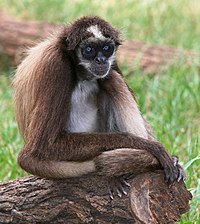Portal:Primates/Selected picture
Nominations
Promoted articles
Featured pictures at Wikipedia or Wikimedia Commons can be automatically included without consensus. Valued pictures here at the Wikipedia can be included automatically as well. To include a featured picture or valued picture, simply choose the next selected picture number from the archive below, click the red link, and paste the following code:
{{Portal:Primates/Selected picture/Layout
|image=
|size= 200px
|status=
|credit=
|text=
|link=
}}
Be sure to fill in the parameters. Place the file name (excluding FILE:) in the image field and provide a suitable caption in the text field. Give credit to the creator. If a Wikipedian created the image, use the format [[User:USERNAME|USERNAME]]. Provide a relevant link to an article that covers the subject. Do not use brackets for the link. By default, the size is left at 300px. Feel free to be bold and change it if necessary.
If the image is a featured picture here in Wikipedia, paste FP into the status field. For a featured picture at Commons, paste FPcommons. Paste VP if the image is a valued picture.
Archive
Selected picture 1
Portal:Primates/Selected picture/1

A Barbary macaque (Macaca sylvanus) by the Upper Rock Nature Reserve in Gibraltar. Although the species is commonly referred to as the "Barbary ape", it is in fact a monkey. The Barbary macaque population in Gibraltar is the last in the whole of the European continent. A popular belief holds that as long as Barbary macaques exist on Gibraltar, the territory will remain under British rule.
Selected picture 2
Portal:Primates/Selected picture/2

The mandrill is the world's largest species of monkey. The word mandrill means "man-ape" according to the Oxford English Dictionary.
Selected picture 3
Portal:Primates/Selected picture/3

Emperor tamarins inhabit tropical rain forests, living deep in the forest and also in open tree-covered areas. This diurnal species walks or runs quadrupedally through the forest, spending the majority of its days in the trees with quick, safe movements and broad jumps among the limbs.
Selected picture 4
Portal:Primates/Selected picture/4

The white-fronted capuchin, Cebus albifrons, is a species of capuchin monkey, a type of New World primate, found in seven different countries in South America: Bolivia, Brazil, Colombia, Venezuela, Ecuador, Peru, and Trinidad and Tobago. The species is divided into several different subspecies, though the specific divisions are uncertain and controversial.
Selected picture 5
Portal:Primates/Selected picture/5

The brown spider monkey, Ateles hybridus, is a species of spider monkey, a type of New World monkey, from South America. It is found in Colombia and Venezuela. Like all spider monkeys, it has very long, spindly limbs and a lengthy prehensile tail which can almost be called a fifth limb. The tail is made up of highly flexible, hairless tips with skin grooves which improves grip on tree branches and is adapted to its strictly arboreal lifestyle. It is currently critically endangered, with few examples of them remaining in the wild.
Selected picture 6
Portal:Primates/Selected picture/6

The ring-tailed lemur (Lemur catta) is a large strepsirrhine primate and the most recognized lemur due to its long, black and white ringed tail. It belongs to Lemuridae, one of five lemur families, and is the only member of the Lemur genus. Like all lemurs it is endemic to the island of Madagascar. Known locally in Malagasy as maky (spelled maki in French) or hira, it inhabits gallery forests to spiny scrub in the southern regions of the island. It is omnivorous and the most terrestrial of lemurs. The animal is diurnal, being active exclusively in daylight hours.
